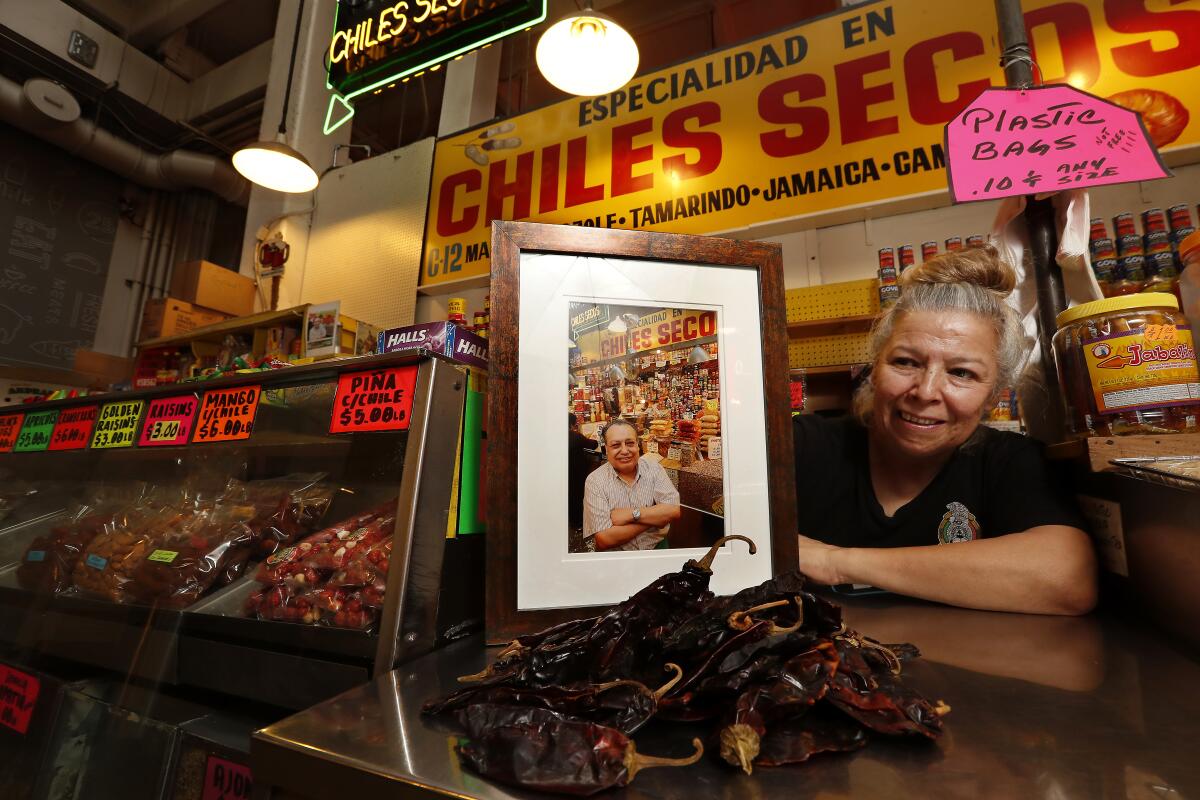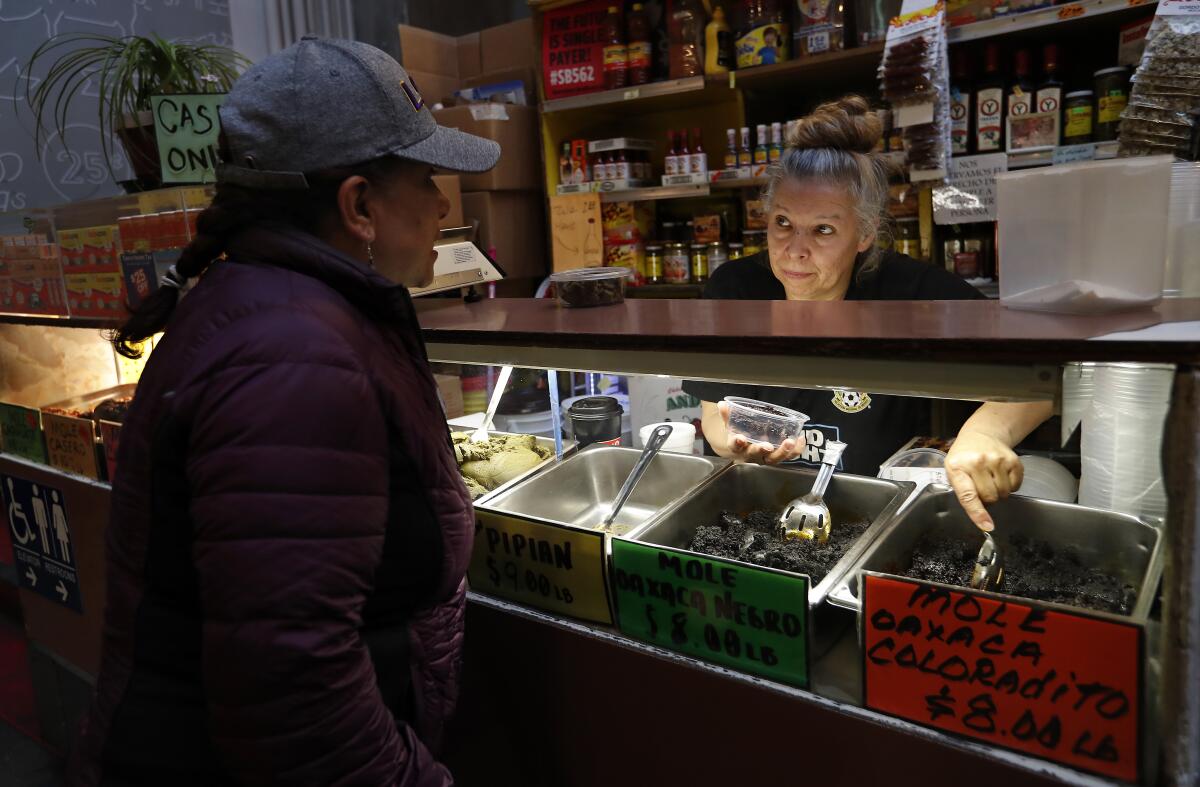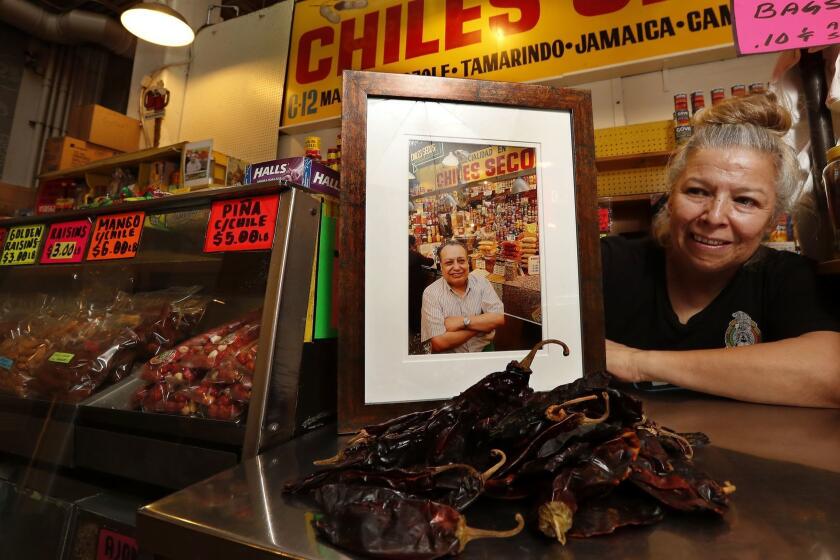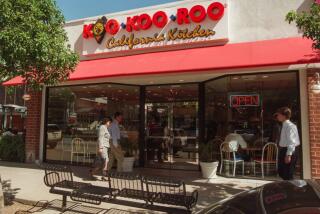Chiles Secos bows out after nearly 50 years at Grand Central Market. ‘Maybe we don’t belong there anymore.’

With its colorful rows of dried chiles, beans, nuts, seasonings and a rainbow of mole pastes imported weekly from Mexico, Grand Central Market’s Chiles Secos was one of the historic food hall’s most beloved one-stop pantry shops for roughly 50 years. This month it closed — but it might not be gone for good.
One of the market’s few remaining vendors from the 1970s has ended its run, as first reported by walking-tour company Esotouric and confirmed by representatives for Grand Central Market. But the granddaughter of the man who put the stand and its mole selection on the map is hoping to eventually reprise it in a new format and for a new era, filling the shoes of both Celestino Lopez and his daughter, Rocio Lopez, who inherited the stall from her late father. According to Claudia Armendariz, her aunt was simply ready for a rest.
“She was ready to retire and nobody could or wanted to keep it going,” Armendariz said. “It was just time; having to run the business and be there every day takes a toll. She’s a grandma, and she just wanted to spend time with her family.”
Column: Amid the hipster foodies of Grand Central Market, one longtime chile vendor tries to hang on
As I strolled through Grand Central Market in downtown Los Angeles one day, one of the longtime vendors flashed her big smile at me, so I stopped to ask how things were going.
Lopez didn’t set an official closing date — instead choosing to phase out her stall quietly — though her last day in Grand Central Market was April 2. According to her niece, she’d made the decision to retire last fall. From there, the family planned their long exit.
Rocio Lopez inherited the stand from her father, who purchased the business from its founder. Back then it wasn’t Chiles Secos but A&B Coffee, where Celestino Lopez worked in 1975 in addition to his stints at multiple other stalls within Grand Central Market. He later purchased it, but it wasn’t until the 1990s that he began to offer what would become the stand’s iconic items: moles handmade by families across Mexico.
A hand-painted, eye-catching yellow-and-red sign was hung behind the register, signaling the wares: CHILES SECOS, or dried chiles. A 1991 episode of “California’s Gold” found host and beloved TV personality Huell Howser chatting with Celestino Lopez and perusing the stall, the front cases filled with small mountains of ground chile de árbol and crushed red pepper flakes that would someday give way to heaps of pepita, rojo and coloradito moles scooped out into plastic to-go containers by large silver spoons.
A blend — or clash — of old and new at Grand Central Market
The flavorful moles are purchased through an importer, which sources its range of pastes from small, family-run operations primarily located in Oaxaca, Puebla and Guerrero in Mexico. These business ties have now spanned decades and generations.
“Our relationship with them is strong; it’s the relationship that my grandfather cultivated,” Armendariz said. “That’s why we’ve been in business together for so long: We have that bond.”
When Rocio Lopez took over, she expanded the range of moles and said that throughout the pandemic, the moles are what helped keep the stall afloat while business began to dwindle across the market. The pandemic was far from the only major change Lopez witnessed through the years.

In 2018 Lopez detailed her struggle amid the draw of newer vendors in the market as it began its evolution into a food hall, telling The Times, “With the changes they’ve made, I’ve lost a lot of my customers.” It became hard to compete, and she revealed that she owed nearly $100,000 in back rent on her Chiles Secos stall. (Armendariz declined to comment on whether the issue of back rent had been resolved.)
In 2020, regarding the food hall’s gentrification, Lopez said, “I don’t even think about it anymore, when there’s new and old together, but I think it looks good. Some of the other [vendors] are over there — like a little piece of the old one. It’s surprising to people; they say, ‘Oh, this is the original.’”
Armendariz too has seen changes in the food hall’s vendors. The now-owner of Chiles Secos began helping at the stall when she was 11 and remembers Grand Central Market from decades past. Now 37, she recalls the days when the floor was covered in sawdust and the tienditas were far from outliers in a sea of destination food stands from some of L.A.’s most notable chefs.
Armendariz says the current owners of Grand Central Market have been incredibly kind to her family and actively sought to aid and keep the market’s legacy vendors running, for which she is grateful. Still, the third-generation Chiles Secos owner said that the changing landscape simply no longer felt like the right fit for the concept.
“Walking around the market now, it’s just not the same place,” she said. “I just kind of felt like I would rather bow out gracefully and accept that maybe we don’t belong there anymore. But we still belong in the world.”
After Esotouric posted news of the closure on Twitter, comments, tweets and messages began rolling in. On Monday Grand Central Market posted a farewell to the long-running stand on the food hall’s Instagram account, congratulating Rocio Lopez on her retirement. A photo slideshow depicted the case of moles and the smiling faces of Rocio and Celestino Lopez behind the counter through the years.
The outpouring, Armendariz said, has been tremendous.
“We’re so grateful that people care and remember my grandpa,” she said, tearing up. “That stall was my grandpa’s everything. You know, he did it for us, and I always looked at it as my inheritance — what he left me — and that’s why I’ll never give up on Chiles Secos.”
In 2013 she helped move the shop into the digital era by building its social media presence, which she’s run for the last decade, and it’s through the digital space that Armendariz hopes to relaunch the shop in the near future. She says she will continue focusing on the moles, though her full business plan is still a work in progress.
She hopes to announce the future of Chiles Secos by the end of the year, but in the nearer future aims to bring the shop’s signature moles to fans who want them, whether through a limited digital storefront or collaborations with chefs.
“I just want people to know they haven’t seen the last of us — we’re not done,” Armendariz said. “Our time at the Grand Central Market is over and it’s a big deal, and we’re sad. We cherished our time there, but we’re not exactly done.”
For those already missing Chiles Secos’ signature moles, Armendariz says the best means of keeping updated is via the shop’s Instagram account and to be on the lookout for announcements.
“I just don’t want people to forget about us because we’re not — it’s not — over,” Armendariz said.
More to Read
Eat your way across L.A.
Get our weekly Tasting Notes newsletter for reviews, news and more.
You may occasionally receive promotional content from the Los Angeles Times.











